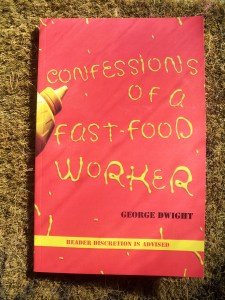Student attracts national attention from self-published book
April 14, 2014
“The splat the tomato created upon impact with the grimy tile was music to my ears. I bent over, picked the slice up, and flipped it to the other side. I let go again. Timber! The second splat was even more thunderous and wet-sounding than the first.”
This is a passage from “Confessions of a Fast-Food Worker,” written by George Dwight Murff Jr., English writing senior. Murff said he got the idea of writing the book when he was 15 years old, lived in Indianapolis and worked at “Ronny’s.” Ronald’s is the name he uses instead of “McDonald’s” in his book, Murff said.
“It took about five months every Sunday night,” Murff said. “I would write a complete story from start to finish each week.”
Murff said he would write for a while and then leave it alone for a month and a half. Then, he would start reading through it to revise it.
“I actually had one of my classmates read over it before I sent it off,” Murff said. “She made little comments out to the side to what didn’t make sense.”
Melanie Mitchum, English major, was the student who edited Murff’s book.
“On the surface the book is comical,” Mitchum said. “He tells his stories with wit, and they are universally appealing as almost any reader can relate to life in the fast-food industry whether they have been customers, employed there or both.”
But what Murff also does is bring attention to the way fast-food workers are treated, Mitchum said. She said the book shows what it is like to be behind the counter on the receiving end of rude and demanding individuals.
“Confessions of a Fast-Food Worker” is a recollection of stories filled with pranks that Murff and his co-workers pulled on dissatisfying customers, Murff said. Last September, when many fast-food workers were striking, 60 news stations picked up his press release, Murff said.
“That’s how ‘20/20’ heard about me,” Murff said. “Folks perceived me as being a part of the fast-food workers’ strike, because I just happened to put my book out at the same time. It was just a coincidence.”
Murff said the news program wanted “Ronny’s” to be on board with the book and also wanted Murff to still be employed with the franchise. “20/20” wanted to come to IU Southeast and accompany Murff on campus to shoot some footage and then fly him out to New York to do the show, but Murff said they seemed disinterested when they found out he was no longer employed with the franchise.
Murff published the book on eBook format Sept. 2, 2013. He said he published it through Nook Press, Amazon and Smashwords, three popular eBook services. Murff said that he wanted to publish his work on his own.
“I have liabilities,” Murff said. “I worked at McDonald’s and wrote about some terrible stuff that my co-workers and I did,” Murff said. “Some companies aren’t going to want to touch that.”
Craig Green, English writing and literature sophomore, said he has known Murff since 2012 and likes him because of his sense of humor and creativity.
“Murff has an approachable style of telling his story, and I can relate to it, because I am also from the working class,” Green said. “He has an interest in media and culture and sees a value in learning from the past and using it to understand the present.”
Green said that Murff is willing to experiment, express himself and step into a larger world.
“I believe that he will be a successful man,” Green said.
Jasmine Riddlespriger, general studies senior and Murff’s girlfriend, said she likes the book but that it has too much profanity for her taste.
“He doesn’t rush with his projects,” Riddlespriger said. “He takes the time to fully complete each one perfectly.”
Some of the projects Riddlespriger is referring to are the ‘mini-cities’ that Murff builds.
“When I was around 10 years old,” Murff said, “I built my first model of downtown Indianapolis. It was about the size of two large tables put together. I make them a lot smaller now, so I can put them in my car.”
Murff said he makes the ‘mini-cities’ from mat board. He cuts and paints them different colors for the different cities that he makes.
“I take my books and my ‘mini-cities’ to flea markets to sell,” Murff said. “I put the number of McDonald’s and Subways in each of the cities that I build. There are 82 Subways and 48 McDonald’s just in downtown Indianapolis.”
Murff said that he builds each of the tall buildings to scale, because they make the skyline. It takes him about a month to create a city like Louisville or Indianapolis.
“That’s working on it between classes and at night,” Murff said. “Any spare time I have. I don’t watch TV much.”
Green said that Murff intertwining his ‘mini-cities’ with his book is a great marketing idea, because the cities are eye-catching.
“I thought he developed a good strategy,” Green said. “He wants to get his name and work out there, and I admire that.”
Murff said he is currently working on three projects.
“There’s a second book called ‘Confessions of a Fast-Food Worker Part Two,’ Murff said. “This is more of a psychological thing as to what it meant to be a fast-food worker.”
Murff said he worked at four different McDonald’s stores and had different reasons for transferring.
“The book basically details how I went in there as a 15-year-old who just wanted a job,”Murff said. “Because of how you are treated in fast-food with people throwing food at you and all that goes on. How that really changes you as a person by the time you are 20. I worked there for five years.”
Murff said that he intends to release the sequel to “Confessions of a Fast-Food Worker” by the end of the summer. He has another book project in mind as well, called “Nobody Likes a Bill Collector.”
“I’m trying to write this book in such a way as a movie or a play,” Murff said. “It’s dramatized fiction.”


